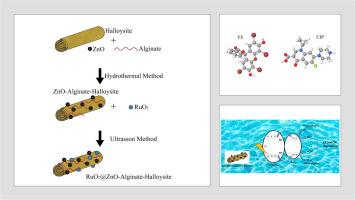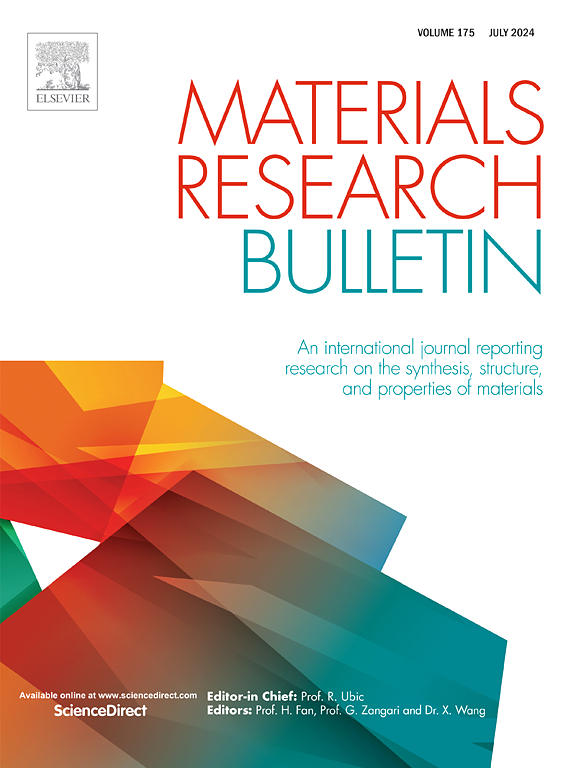A novel RuO₂@ZnO-Alginate-Halloysite composite for the effective degradation of Eosin Yellow dye and Ciprofloxacin drug
IF 5.3
3区 材料科学
Q2 MATERIALS SCIENCE, MULTIDISCIPLINARY
引用次数: 0
Abstract
This research explores the synthesis and application of a novel RuO₂@ZnO-Alginate-Halloysite composite to effectively mitigate Eosin Yellow (EY) and Ciprofloxacin (CIP). The composite exhibited a predominant zinc oxide (ZnO) phase with added ruthenium oxide (RuO₂), alginate, and halloysite components, confirmed through X-ray diffractogram (XRD), Raman, and Fourier Transform Infrared Spectroscopy (FTIR). The addition of RuO₂ did not alter the crystal structure significantly. Still, it impacted the optical properties, with the band gap energies ranging from 3.281 to 3.252 eV, indicating a redshift associated with increased RuO₂ concentration. The composites were tested for EY and CIP photocatalytic degradation under UV light. The composites containing 2 and 3 % of RuO2 presented impressive photocatalytic performance, achieving up to 82.53 % degradation of CIP and 68.68 % of EY under UV irradiation respectively, highlighting its potential as a robust solution for environmental remediation. The study employed a series of scavenger tests to identify the primary reactive species involved in the photocatalytic degradation of ciprofloxacin drug and eosin yellow dye. The introduction of benzoquinone led to a significant decrease in photocatalytic activity, indicating that superoxide (•O₂⁻) and hydroxyl radicals (•OH) are the dominant species in the photocatalytic degradation of CIP and EY, respectively. The synergistic effects of these reactive species contribute significantly to the photocatalytic performance of the composite material. Finally, the composites showed good recyclability, maintaining substantial degradation performance over multiple cycles. The significance of this study is underscored by the urgent need to find effective methods for removing hazardous compounds from wastewater, a growing concern due to their harmful impact on aquatic ecosystems and human health.

一种有效降解曙红染料和环丙沙星药物的新型 RuO₂@ZnO-Alginate-Halloysite 复合材料
本研究探索了一种新型 RuO₂@ZnO-Alginate-Halloysite 复合材料的合成和应用,该材料可有效缓解伊红(EY)和环丙沙星(CIP)。经 X 射线衍射图 (XRD)、拉曼光谱和傅立叶变换红外光谱 (FTIR) 证实,该复合材料以氧化锌 (ZnO) 相为主,并添加了氧化钌 (RuO₂)、海藻酸盐和哈洛石成分。RuO₂ 的加入并没有明显改变晶体结构。不过,它还是影响了光学特性,带隙能在 3.281 至 3.252 eV 之间,表明随着 RuO₂ 浓度的增加而发生了红移。复合材料在紫外光下进行了 EY 和 CIP 光催化降解测试。RuO2 含量分别为 2% 和 3% 的复合材料表现出令人印象深刻的光催化性能,在紫外线照射下,CIP 和 EY 的降解率分别高达 82.53% 和 68.68%,凸显了其作为一种可靠的环境修复解决方案的潜力。研究采用了一系列清除剂测试,以确定参与环丙沙星药物和曙红黄色染料光催化降解的主要反应物。引入苯醌会导致光催化活性显著下降,这表明超氧自由基(-O₂-)和羟自由基(-OH)分别是光催化降解环丙沙星和曙红染料的主要反应物。这些反应物的协同效应大大提高了复合材料的光催化性能。最后,复合材料显示出良好的可回收性,在多次循环中仍能保持可观的降解性能。由于有害化合物对水生生态系统和人类健康的有害影响,人们越来越关注如何找到有效的方法去除废水中的有害化合物,这也凸显了本研究的重要意义。
本文章由计算机程序翻译,如有差异,请以英文原文为准。
求助全文
约1分钟内获得全文
求助全文
来源期刊

Materials Research Bulletin
工程技术-材料科学:综合
CiteScore
9.80
自引率
5.60%
发文量
372
审稿时长
42 days
期刊介绍:
Materials Research Bulletin is an international journal reporting high-impact research on processing-structure-property relationships in functional materials and nanomaterials with interesting electronic, magnetic, optical, thermal, mechanical or catalytic properties. Papers purely on thermodynamics or theoretical calculations (e.g., density functional theory) do not fall within the scope of the journal unless they also demonstrate a clear link to physical properties. Topics covered include functional materials (e.g., dielectrics, pyroelectrics, piezoelectrics, ferroelectrics, relaxors, thermoelectrics, etc.); electrochemistry and solid-state ionics (e.g., photovoltaics, batteries, sensors, and fuel cells); nanomaterials, graphene, and nanocomposites; luminescence and photocatalysis; crystal-structure and defect-structure analysis; novel electronics; non-crystalline solids; flexible electronics; protein-material interactions; and polymeric ion-exchange membranes.
 求助内容:
求助内容: 应助结果提醒方式:
应助结果提醒方式:


